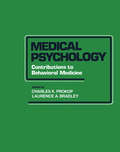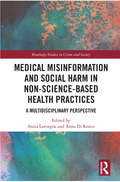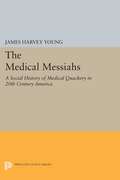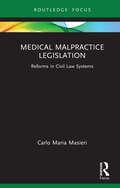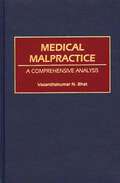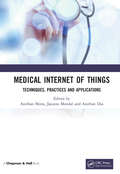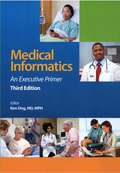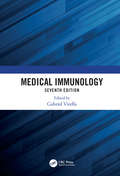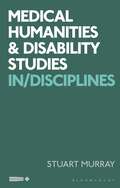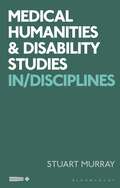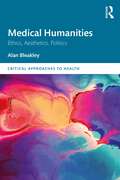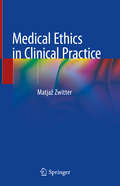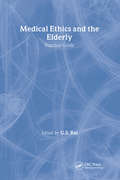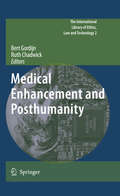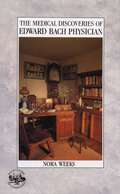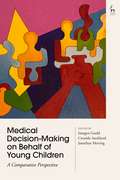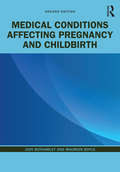- Table View
- List View
Medical Psychology: Contributions to Behavioral Medicine
by Charles K. Prokop Laurence A. BradleyMedical Psychology: Contributions to Behavioral Medicine discusses the relationship between medical psychology and behavioral medicine and includes critical reviews of the status of diagnostic, treatment, and preventive approaches to a wide variety of medical disorders such as hypertension, cancer, and chronic pain. A quantitative and qualitative approach to neuropsychological evaluation is also presented.Comprised of 26 chapters, this book begins by tracing the history of the relationship between psychology and medicine and assessing the status of psychology's role in the medical center. The second and third sections deal with approaches to the assessment, treatment, and prevention of various medical disorders including hypertension, cancer, and cardiovascular disease. The third section also examines several special problems within the provinces of medical psychology and behavioral medicine. The fourth section presents reviews of clinical and research topics of particular interest to all medical psychologists and behavioral medicine specialists, including adherence to health care regimens and professional services evaluation in a medical setting. This monograph will be of value to research investigators and practitioners within the behavioral sciences and medicine.
Medical Misinformation and Social Harm in Non-Science Based Health Practices: A Multidisciplinary Perspective (Routledge Studies in Crime and Society)
by Anita Lavorgna Anna Di RoncoFraudulent, harmful, or at best useless pharmaceutical and therapeutic approaches developed outside science-based medicine have boomed in recent years, especially due to the commercialisation of cyberspace. The latter has played a fundamental role in the rise of false ‘health experts’, and in the creation of filter bubbles and echo chambers that have contributed to the formation of highly polarised debates on non-science-based health practices—online as well as offline. By adopting a multidisciplinary approach, this edited book brings together contributions of international academics and practitioners from criminology, digital sociology, health psychology, medicine, law, physics, and journalism, where they critically analyse different types of non-science-based health approaches. With this volume, we aim to reconcile different scientific understandings of these practices, synthesising a variety of empirical, theoretical and interpretative approaches, and exploring the challenges, implications and potential remedies to the spread of dangerous and misleading health information. This edited book will offer some food for thought not only to students and academics in the social sciences, health psychology and medicine among other disciplines, but also to medical practitioners, science journalists, debunkers, policy makers and the general public, as they might all benefit from a greater awareness and critical knowledge of the harms caused by non-scientific health practices.
Medical Misinformation and Social Harm in Non-Science Based Health Practices: A Multidisciplinary Perspective (Routledge Studies in Crime and Society)
by Anita Lavorgna Anna Di RoncoFraudulent, harmful, or at best useless pharmaceutical and therapeutic approaches developed outside science-based medicine have boomed in recent years, especially due to the commercialisation of cyberspace. The latter has played a fundamental role in the rise of false ‘health experts’, and in the creation of filter bubbles and echo chambers that have contributed to the formation of highly polarised debates on non-science-based health practices—online as well as offline. By adopting a multidisciplinary approach, this edited book brings together contributions of international academics and practitioners from criminology, digital sociology, health psychology, medicine, law, physics, and journalism, where they critically analyse different types of non-science-based health approaches. With this volume, we aim to reconcile different scientific understandings of these practices, synthesising a variety of empirical, theoretical and interpretative approaches, and exploring the challenges, implications and potential remedies to the spread of dangerous and misleading health information. This edited book will offer some food for thought not only to students and academics in the social sciences, health psychology and medicine among other disciplines, but also to medical practitioners, science journalists, debunkers, policy makers and the general public, as they might all benefit from a greater awareness and critical knowledge of the harms caused by non-scientific health practices.
The Medical Messiahs: A Social History of Health Quackery in 20th Century America
by James Harvey YoungJames Harvey Young describes the development of patent medicines in America from the enactment in 1906 of the Pure Food and Drugs Act through the mid-1960s. Many predicted that the Pure Food and Drugs Act would be the end of harmful nostrums, but Young describes in colorful detail post-Act cases involving manufacturers and promoters of such products as Cuforhedake Brane-Fude, B. & M. "tuberculosis-curing" liniment, and the dangerous reducing pill Marmola. We meet, among others, the brothers Charles Frederick and Peter Kaadt, who treated diabetic patients with a mixture of vinegar and saltpeter; Louisiana state senator Dudley J. LeBlanc, who put on fabulous medicine shows as late as the 1950s promoting Hadacol and his own political career, and Adolphus Hohensee, whose lectures on nutrition provide a classic example of the continuing appeal of food faddism.Review:"The Medical Messiahs is an example of historical writing at its best—scholarly, perceptive, and exceedingly readable. Despite his objectivity, Young's dry humor shines through and illuminates his entire book."—John Duffy, Journal of Southern History"This book is written in tight, graceful prose that reflects thought rather than substitutes for it. Done with a sure feel for the larger political, social, and economic background, it demonstrates that historians who would make socially relevant contributions need only adhere to the best canons of their art."—Oscar E. Anderson, Jr., The American Historical Review"[This] material is so interestingly presented that the readers may not immediately appreciate what a major historic study [the book] is, and how carefully documented and critically analyzed."—Lester S. King, Journal of the American Medical Association"Dr. Young's well-written social history of health quackery in twentieth-century America will not only increase the understanding of our times by future historians but will also be of great value to all those interested in improving the health of the population by reminding them of the past."—F. M. Berger, The American ScientistOriginally published in 1967.The Princeton Legacy Library uses the latest print-on-demand technology to again make available previously out-of-print books from the distinguished backlist of Princeton University Press. These editions preserve the original texts of these important books while presenting them in durable paperback and hardcover editions. The goal of the Princeton Legacy Library is to vastly increase access to the rich scholarly heritage found in the thousands of books published by Princeton University Press since its founding in 1905.
Medical Malpractice Legislation: Reforms in Civil Law Systems (Young Feltrinelli Prize in the Moral Sciences)
by Carlo Maria MasieriThis book aims to analyse the legal tools that the legislatures of France, Germany and Italy adopted in order to regulate medical malpractice.In the mid-1970s, a reform movement started in the United States, where there was considerable concern about then ongoing medical malpractice crises. Since the beginning of the current century, France, Germany and Italy have passed statutes that aim to reform medical liability rules. Thus, it is first interesting to assess whether any medical malpractice crises have been identified in these systems and, second, how these have been faced through the passing of new statutes on the continent. Accordingly, the first chapter explores the idea of medical malpractice crisis and its relationship with the insurance market, also considering the reflections of American scholars. It then reconstructs the French, German and Italian legal frameworks, as well as their insurance and litigation contexts, reviewing and commenting on the quantitative evidence that was collected before the reforms. The second chapter briefly summarises the debate on medical malpractice reforms in France, Germany and Italy. It then analyses the statutes that have been passed, distinguishing between reforms that consolidate case law and reforms that introduce innovative solutions, sometimes repealing court-developed doctrines. In particular, the chapter examines in a comparative perspective the diff erent options adopted in these civil law countries with regard to the rules on liability, burden of proof, statute of limitations and damages. Moreover, the chapter examines the reforms of insurance, procedural and evidence law, to the extent they affect medical malpractice cases. The third chapter reviews and analyses the current available data related to medical malpractice litigation and insurance after the reforms adopted in France, Germany and Italy, in order to find out evidence of their effectiveness and efficiency. It also highlights some aspects of medical malpractice law that still belong to the domain of the judiciary. It finally points out which problems may be addressed by the legislatures and what further data should be collected in the future.This work may interest legal scholars, healthcare providers, insurers and policymakers.
Medical Malpractice Legislation: Reforms in Civil Law Systems (Young Feltrinelli Prize in the Moral Sciences)
by Carlo Maria MasieriThis book aims to analyse the legal tools that the legislatures of France, Germany and Italy adopted in order to regulate medical malpractice.In the mid-1970s, a reform movement started in the United States, where there was considerable concern about then ongoing medical malpractice crises. Since the beginning of the current century, France, Germany and Italy have passed statutes that aim to reform medical liability rules. Thus, it is first interesting to assess whether any medical malpractice crises have been identified in these systems and, second, how these have been faced through the passing of new statutes on the continent. Accordingly, the first chapter explores the idea of medical malpractice crisis and its relationship with the insurance market, also considering the reflections of American scholars. It then reconstructs the French, German and Italian legal frameworks, as well as their insurance and litigation contexts, reviewing and commenting on the quantitative evidence that was collected before the reforms. The second chapter briefly summarises the debate on medical malpractice reforms in France, Germany and Italy. It then analyses the statutes that have been passed, distinguishing between reforms that consolidate case law and reforms that introduce innovative solutions, sometimes repealing court-developed doctrines. In particular, the chapter examines in a comparative perspective the diff erent options adopted in these civil law countries with regard to the rules on liability, burden of proof, statute of limitations and damages. Moreover, the chapter examines the reforms of insurance, procedural and evidence law, to the extent they affect medical malpractice cases. The third chapter reviews and analyses the current available data related to medical malpractice litigation and insurance after the reforms adopted in France, Germany and Italy, in order to find out evidence of their effectiveness and efficiency. It also highlights some aspects of medical malpractice law that still belong to the domain of the judiciary. It finally points out which problems may be addressed by the legislatures and what further data should be collected in the future.This work may interest legal scholars, healthcare providers, insurers and policymakers.
Medical Malpractice: A Comprehensive Analysis
by Vasanthaku N. BhatThe healthcare delivery system in the United States is inundated with medical malpractice and liability issues, and there is no consensus about causes or solutions. Both physicians and an alliance of lawyers and consumer groups agree that there is a crisis, but physicians claim that the current medical malpractice system inheres in too many lawsuits while the lawyers argue that the current level of litigation is insufficient. Multivariate statistical methods are used in this much needed effort to investigate the effects of medical malpractice on various aspects of health care.After introducing the various tort reforms that have been proposed and implemented by some states, the author analyzes the impact of these reforms on medical malpractice payment rates, claim payments, malpractice insurance, and in dental malpractice. The impact of malpractice liability on costs, licensure, disciplinary action, the supply of physicians, and the practice of defensive medicine are also covered. This is an essential guide for students in law, medicine, and health administration, as well as anyone who wants to research these issues for public policy.
Medical Internet of Things: Techniques, Practices and Applications
by Anirban MitraIn recent years, the Medical Internet of Things (MIoT) has emerged as one of the most helpful technological gifts to mankind. With the incredible development in data science, big data technologies, IoT and embedded systems, it is now possible to collect a huge amount of sensitive and personal data, compile it and store it through cloud or edge computing techniques. However, important concerns remain about security and privacy, the preservation of sensitive and personal data, and the efficient transfer, storage and processing of MIoT-based data. Medical Internet of Things: Techniques, Practices and Applications is an attempt to explore new ideas and novel techniques in the area of MIoT. The book is composed of fifteen chapters discussing basic concepts, issues, challenges, case studies and applications in MIoT. This book offers novel advances and applications of MIoT in a precise and clear manner to the research community to achieve in-depth knowledge in the field. This book will help those interested in the field as well as researchers to gain insight into different concepts and their importance in multifaceted applications of real life. This has been done to make the book more flexible and to stimulate further interest in the topic. Features: A systematic overview of concepts in Medical Internet of Things (MIoT) is included. Recent research and some pointers on future advancements in MIoT are discussed. Examples and case studies are included. It is written in an easy-to-understand style with the help of numerous figures and datasets. This book serves as a reference book for scientific investigators who are interested in working on MIoT, as well as researchers developing methodology in this field. It may also be used as a textbook for postgraduate-level courses in computer science or information technology.
Medical Internet of Things: Techniques, Practices and Applications
by Anirban Mitra Jayanta Mondal Anirban DasIn recent years, the Medical Internet of Things (MIoT) has emerged as one of the most helpful technological gifts to mankind. With the incredible development in data science, big data technologies, IoT and embedded systems, it is now possible to collect a huge amount of sensitive and personal data, compile it and store it through cloud or edge computing techniques. However, important concerns remain about security and privacy, the preservation of sensitive and personal data, and the efficient transfer, storage and processing of MIoT-based data. Medical Internet of Things: Techniques, Practices and Applications is an attempt to explore new ideas and novel techniques in the area of MIoT. The book is composed of fifteen chapters discussing basic concepts, issues, challenges, case studies and applications in MIoT. This book offers novel advances and applications of MIoT in a precise and clear manner to the research community to achieve in-depth knowledge in the field. This book will help those interested in the field as well as researchers to gain insight into different concepts and their importance in multifaceted applications of real life. This has been done to make the book more flexible and to stimulate further interest in the topic. Features: A systematic overview of concepts in Medical Internet of Things (MIoT) is included. Recent research and some pointers on future advancements in MIoT are discussed. Examples and case studies are included. It is written in an easy-to-understand style with the help of numerous figures and datasets. This book serves as a reference book for scientific investigators who are interested in working on MIoT, as well as researchers developing methodology in this field. It may also be used as a textbook for postgraduate-level courses in computer science or information technology.
Medical Informatics: An Executive Primer, Third Edition
by William N. Kelly Kenneth R. OngThis third edition of HIMSS' award-winning, bestseller explores how clinicians, patients, and health IT stakeholders are collaborating to support high-value care through health IT. Medical Informatics: An Executive Primer continues to explore information technologies applied in hospital settings, at the physician's office and in patients' homes to
Medical Immunology, 7th Edition
by Gabriel VirellaThis seventh edition of Medical Immunology, now in a full-color presentation, continues to provide a succinct clinical review of the human response to infection while being firmly grounded in science. The authors, distinguished and experienced educators, have been able to anticipate readers’ conceptual challenges and use illustrations, diagrams, and algorithms throughout to simplify complex concepts. With an emphasis on clinical applications, methodological advances, immunological diseases, and innovative interventions, this tried and true guide navigates readers through state-of-the-sciences technologies and demonstrates their implementation in the day-to-day clinical practice of immunology. Key Features Stresses both the basic scientific concepts and clinical correlations to medical practice. Progresses logically from normal immune function to abnormalities and clinical diseases. Reviews the diagnosis, pathogenesis, and management of autoimmune diseases in a concise, manageable and visual manner Continues to be the only current medically-focused immunology text available Provides a succinct review of human response to infection with a focus on diagnostic and clinical immunology
Medical Immunology, 7th Edition
by Gabriel VirellaThis seventh edition of Medical Immunology, now in a full-color presentation, continues to provide a succinct clinical review of the human response to infection while being firmly grounded in science. The authors, distinguished and experienced educators, have been able to anticipate readers’ conceptual challenges and use illustrations, diagrams, and algorithms throughout to simplify complex concepts. With an emphasis on clinical applications, methodological advances, immunological diseases, and innovative interventions, this tried and true guide navigates readers through state-of-the-sciences technologies and demonstrates their implementation in the day-to-day clinical practice of immunology. Key Features Stresses both the basic scientific concepts and clinical correlations to medical practice. Progresses logically from normal immune function to abnormalities and clinical diseases. Reviews the diagnosis, pathogenesis, and management of autoimmune diseases in a concise, manageable and visual manner Continues to be the only current medically-focused immunology text available Provides a succinct review of human response to infection with a focus on diagnostic and clinical immunology
Medical Humanities and Disability Studies: In/Disciplines (Critical Interventions in the Medical and Health Humanities)
by Stuart MurrayMedical humanities and disability studies are disciplines at the cutting edge of innovative critical work in the study of health and disability, but to date there has been no book-length examination of the relationship between the two. Although each has emerged from different heritages, they share many features, from discussing the complexities of embodiment, identifying processes of exclusion and championing user participation, to a commitment to new forms of critical writing. In/Disciplines explores the connections between the two disciplines in detail. It presents a series of provocations about how they interact, the forms their practice take, and their strengths and weaknesses as working methods. With a focus on life stories that give accounts of health and disability experiences, it mixes creative and critical writing in an accessible manner aimed at a wide audience in both Medical Humanities and Disability Studies, and across new humanities more widely. The book asserts that both disciplines need to evaluate and challenge core assumptions if they are to remain critically relevant in the evolving study of social and cultural understanding of health and disability.
Medical Humanities and Disability Studies: In/Disciplines (Critical Interventions in the Medical and Health Humanities)
by Stuart MurrayMedical humanities and disability studies are disciplines at the cutting edge of innovative critical work in the study of health and disability, but to date there has been no book-length examination of the relationship between the two. Although each has emerged from different heritages, they share many features, from discussing the complexities of embodiment, identifying processes of exclusion and championing user participation, to a commitment to new forms of critical writing. In/Disciplines explores the connections between the two disciplines in detail. It presents a series of provocations about how they interact, the forms their practice take, and their strengths and weaknesses as working methods. With a focus on life stories that give accounts of health and disability experiences, it mixes creative and critical writing in an accessible manner aimed at a wide audience in both Medical Humanities and Disability Studies, and across new humanities more widely. The book asserts that both disciplines need to evaluate and challenge core assumptions if they are to remain critically relevant in the evolving study of social and cultural understanding of health and disability.
Medical Humanities: Ethics, Aesthetics, Politics (Critical Approaches to Health)
by Alan BleakleyThis ground-breaking book sets out a fresh vision for a future medical education by providing a radical reconceptualisation of the purposes of medical humanities through a lens of critical health psychology and liberatory pedagogy. The medical humanities are conceived as translational media through which reductive, instrumental biomedicine can be raised in quality, intensity, and complexity by embracing ethical, aesthetic, political, and transcendental values. This translation occurs through innovative use of metaphor. A note of caution is offered – that the medical humanities too can be instrumental and reductive if not framed well. Drawing on major theorists such as Michel Foucault and Jacques Rancière and bringing together insights from diverse but inter-related fields, Bleakley focuses on the "ills" of contemporary biomedicine and medical education, and the need for reconceptualisation, which – it is argued – the translational medical humanities have the potential to accomplish. Current instrumental approaches to medical humanities, embracing communication skills training and narrative-based medicine, have failed to address the chronic symptoms suffered by medicine. These include resort to closed, functional systems thinking rather than embracing dynamic, complex, open, and adaptive systems thinking; lack of democratic habits in medical culture, compromising patient safety and care; the production of insensibility rather than deepening of sensibility in medical education; a lack of attention to ethics, aesthetics, and politics where the instrumental is privileged; and a lack of critical reflexivity in revisioning habitual practices. Through persuasive argument, Bleakley sets out a more radical manifesto for the role the arts and humanities might play in medical/healthcare education and offers a new approach based on curriculum process rather than syllabus content, to recuperate aesthetic sensibilities, discernment, and affect in medicine. The book will appeal to medical and healthcare educators, medical and health humanities scholars, engaged clinicians, social scientists drawing on critical theory, and arts and humanities practitioners engaging with medical and healthcare themes.
Medical Humanities: Ethics, Aesthetics, Politics (Critical Approaches to Health)
by Alan BleakleyThis ground-breaking book sets out a fresh vision for a future medical education by providing a radical reconceptualisation of the purposes of medical humanities through a lens of critical health psychology and liberatory pedagogy. The medical humanities are conceived as translational media through which reductive, instrumental biomedicine can be raised in quality, intensity, and complexity by embracing ethical, aesthetic, political, and transcendental values. This translation occurs through innovative use of metaphor. A note of caution is offered – that the medical humanities too can be instrumental and reductive if not framed well. Drawing on major theorists such as Michel Foucault and Jacques Rancière and bringing together insights from diverse but inter-related fields, Bleakley focuses on the "ills" of contemporary biomedicine and medical education, and the need for reconceptualisation, which – it is argued – the translational medical humanities have the potential to accomplish. Current instrumental approaches to medical humanities, embracing communication skills training and narrative-based medicine, have failed to address the chronic symptoms suffered by medicine. These include resort to closed, functional systems thinking rather than embracing dynamic, complex, open, and adaptive systems thinking; lack of democratic habits in medical culture, compromising patient safety and care; the production of insensibility rather than deepening of sensibility in medical education; a lack of attention to ethics, aesthetics, and politics where the instrumental is privileged; and a lack of critical reflexivity in revisioning habitual practices. Through persuasive argument, Bleakley sets out a more radical manifesto for the role the arts and humanities might play in medical/healthcare education and offers a new approach based on curriculum process rather than syllabus content, to recuperate aesthetic sensibilities, discernment, and affect in medicine. The book will appeal to medical and healthcare educators, medical and health humanities scholars, engaged clinicians, social scientists drawing on critical theory, and arts and humanities practitioners engaging with medical and healthcare themes.
Medical Ethics in Clinical Practice
by Matjaž ZwitterThis book discusses medicine from an ethical perspective, whereas books on medical ethics more commonly present ethics from a bio-medical standpoint. The book is divided into 23 chapters. The introductory chapters present some basic concepts of medical ethics, such as the relation between the legal system and ethics, ethical documents, ethical theories, and ethical analysis. The following chapters address issues of importance in all fields of medicine: respecting autonomy, communication, relations within a healthcare team, professional malpractice, limited resources, and the portrait of a physician. In turn, the third part of the book focuses on ethical aspects in a broad range of medical activities – preventive medicine, human reproduction, genetics, pediatrics, intensive care, palliative medicine, clinical research, unproven methods in diagnostics and treatment, and the role of physicians who aren’t directly responsible for patient care. The last part presents students’ seminars with case stories. The book offers a valuable resource for physicians of all specialties, students of medicine, professionals, and students from other fields devoted to human health, journalists, and general readers with an interest in medicine.
Medical Ethics and the Elderly: practical guide
by Gurcharan S RaiThis concise, introductory handbook discusses the basic principles of medical ethics, and includes practical, realistic guidance on how to evaluate and manage common ethical problems, focusing on the care of elderly patients Typical scenarios faced in clinical practice, such as issues of mental capacity and consent, resuscitation, near death decisions, quality of life, and health care expenditure, are discussed
Medical Ethics and the Elderly: practical guide
by Gurcharan S RaiThis concise, introductory handbook discusses the basic principles of medical ethics, and includes practical, realistic guidance on how to evaluate and manage common ethical problems, focusing on the care of elderly patients Typical scenarios faced in clinical practice, such as issues of mental capacity and consent, resuscitation, near death decisions, quality of life, and health care expenditure, are discussed
Medical Enhancement and Posthumanity (The International Library of Ethics, Law and Technology #2)
by Bert Gordijn Ruth ChadwickAs we are increasingly using new technologies to change ourselves beyond therapy and in accordance with our own desires, understanding the challenges of human enhancement has become one of the most urgent topics of the current age. This volume contributes to such an understanding by critically examining the pros and cons of our growing ability to shape human nature through technological advancements. The authors undertake careful analyses of decisive questions that will confront society as enhancement interventions using bio-, info-, neuro- and nanotechnologies become widespread in the years to come. They provide the reader with the conceptual tools necessary to address such questions fruitfully. What makes the book especially attractive is the combination of conceptual, historical and ethical approaches, rendering it highly original. In addition, the well-balanced structure allows both favourable and critical views to be voiced. Moreover, the work has a crystal clear structure. As a consequence, the book is accessible to a broad academic audience. The issues raised are of interest to a wide reflective public concerned about science and ethics, as well as to students, academics and professionals in areas such as philosophy, applied ethics, bioethics, medicine and health management.
The Medical Discoveries Of Edward Bach Physician
by Nora WeeksIn 1912 Edward Bach qualified as a medical doctor and embarked upon a career which not only had a profound effect on medical science, but brought to ordinary people the world over, a simple, safe and effective system of healing.Dr. Bach made a detailed study of bacteriology, immunology and homeopathy and found a clear connection between chronic disease and negative mental attitudes. It was the relationship between mind and body which formed the basis of his further research and as he became increasingly convinced that emotional harmony was the key to good health, he was determined to find a simple, non-invasive and harmless method of healing which could be used safely by everyone.The Medical Discoveries of Edward Bach tells how Dr. Bach's work developed, from his childhood hopes and dreams of a healthy society, to the discovery of a complete system of 38 natural remedies which address all aspects of human nature, emotional outlook and personality. Edward Bach was an eminent physician whose remarkable contribution to medicine, healing and humanity has yet to be fully realised.
Medical Decision-Making on Behalf of Young Children: A Comparative Perspective
by Imogen Goold, Cressida Auckland and Jonathan HerringIn the wake of the Charlie Gard and Alfie Evans cases, a wide-ranging international conversation was started regarding alternative thresholds for intervention and the different balances that can be made in weighing up the rights and interests of the child, the parent's rights and responsibilities and the role of medical professionals and the courts. This collection provides a comparative perspective on these issues by bringing together analysis from a range of jurisdictions across Europe, North and South America, Africa and Asia. Contextualising the differences and similarities, and drawing out the cultural and social values that inform the approach in different countries, this volume is highly valuable to scholars across jurisdictions, not only to inform their own local debate on how best to navigate such cases, but also to foster inter-jurisdictional debate on the issues. The book brings together commentators from the fields of law, medical ethics, and clinical medicine across the world, actively drawing on the view from the clinic as well as philosophical, legal and sociological perspectives on the crucial question of who should decide about the fate of a child suffering from a serious illness. In doing so, the collection offers comprehensive treatment of the key questions around whether the current best interests approach is still appropriate, and if not, what the alternatives are. It engages head-on with the concerns seen in both the academic and popular literature that there is a need to reconsider the orthodoxy in this area.
Medical Decision-Making on Behalf of Young Children: A Comparative Perspective
In the wake of the Charlie Gard and Alfie Evans cases, a wide-ranging international conversation was started regarding alternative thresholds for intervention and the different balances that can be made in weighing up the rights and interests of the child, the parent's rights and responsibilities and the role of medical professionals and the courts. This collection provides a comparative perspective on these issues by bringing together analysis from a range of jurisdictions across Europe, North and South America, Africa and Asia. Contextualising the differences and similarities, and drawing out the cultural and social values that inform the approach in different countries, this volume is highly valuable to scholars across jurisdictions, not only to inform their own local debate on how best to navigate such cases, but also to foster inter-jurisdictional debate on the issues. The book brings together commentators from the fields of law, medical ethics, and clinical medicine across the world, actively drawing on the view from the clinic as well as philosophical, legal and sociological perspectives on the crucial question of who should decide about the fate of a child suffering from a serious illness. In doing so, the collection offers comprehensive treatment of the key questions around whether the current best interests approach is still appropriate, and if not, what the alternatives are. It engages head-on with the concerns seen in both the academic and popular literature that there is a need to reconsider the orthodoxy in this area.
Medical Conditions Affecting Pregnancy and Childbirth
by Judy Bothamley Maureen BoyleMidwives are encountering more and more women whose pregnancies are complicated by medical conditions, including cardiac disease, obesity and diabetes. This new edition is completely up-to-date and offers highly practical solutions for everyday midwifery practice, acknowledging the importance of promoting normality where possible. This text includes physiology, explanations of conditions and principles of care for preconception, pregnancy, labour, birth and the postnatal period. Each chapter brings together the basic knowledge of a condition and how it changes during pregnancy in an integrated and accessible way, including a new chapter dedicated to obesity. Explanations of laboratory tests, diagnostic tests, common drugs and illustrative colour pictures are included in relevant chapters. Medical Conditions Affecting Pregnancy and Childbirth is a vital guide for student midwives, as well as a useful reference for practising midwives.
Medical Conditions Affecting Pregnancy and Childbirth
by Judy Bothamley Maureen BoyleMidwives are encountering more and more women whose pregnancies are complicated by medical conditions, including cardiac disease, obesity and diabetes. This new edition is completely up-to-date and offers highly practical solutions for everyday midwifery practice, acknowledging the importance of promoting normality where possible. This text includes physiology, explanations of conditions and principles of care for preconception, pregnancy, labour, birth and the postnatal period. Each chapter brings together the basic knowledge of a condition and how it changes during pregnancy in an integrated and accessible way, including a new chapter dedicated to obesity. Explanations of laboratory tests, diagnostic tests, common drugs and illustrative colour pictures are included in relevant chapters. Medical Conditions Affecting Pregnancy and Childbirth is a vital guide for student midwives, as well as a useful reference for practising midwives.
